Nestbox News is an account of activity at a nestbox placed atop Mack-Cali Realty Corporation's 101 Hudson, Jersey City, by biologists in the Endangered
and Nongame Species Program (ENSP). Follow this chronicle of the nesting behavior and activity of peregrine falcons and their chicks.
August 10, 2009
Peregrine watchers Mike G. and Bonnie T. were downtown on Friday (July 31) and Sunday (August 2). They reported quite a bit of flying by the two fledglings in the area of 101 Hudson Street, but also several blocks north and south of there.
On Friday, Bonnie reported the fledglings flying figure eights between Greene Street and 101 Hudson, catching the wind above the building and hovering. On Sunday the whole family was observed flying around the tall Goldman Sachs building just south of 101 Hudson. Mike wrote, "This is the first time I've seen them around the Goldman Sachs tower. I have to admit, my heart jumped into my throat whenever I saw one of them approach the windows of the tower. Each time though, they pulled up and flew alongside the windows/building beautifully."
|
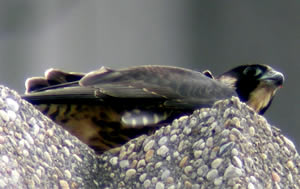
Click to enlarge |
We thank everyone for their devoted interest to the Jersey City peregrines and the webcam. To lend your support financially, please consider becoming a member of the Conserve Wildlife Foundation of New Jersey (www.ConserveWildlifeNJ.org). And your donations on your NJ Income Tax form (Check-Off for Wildlife) support all endangered species work in our state. Finally, 80% of the price of a Conserve Wildlife license plate goes to the Endangered and Nongame Species Program for this work.
July 24, 2009
With the chicks now capable of full flight and rarely in view of the webcam, we have shut the system down until next spring. We will continue to post any news of significance, but it is probably safe for readers of Nestbox News to assume that "no news is good news" as far as the Jersey City peregrines.
We appreciate the support of all our viewers, and especially those who have contributed information and photos. And to those who have made a monetary contribution, we send a heartfelt thanks for helping us do the work we love for the wildlife which is so important to us all.
The live webcam will return in March or April, 2010.
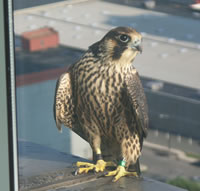
Click to enlarge |
July 22, 2009
Readers of Nestbox News may recall the great shot of an adult peregrine outside an office at Plaza 5 in the July 14 entry. Whether from watching its parent, it being an attractive location or just coincidence, the young male fledgling was recently photographed on the same ledge. Comparing the two birds illustrates the different markings (vertical banding in the fledgling, horizontal in the adult), which are used to distinguish the ages.
We appreciate the input from viewers in Jersey City and elsewhere who have provided us with reports and photos. The support of the public is valued by all those involved with the project.
|
July 17, 2009
Our friend Mike G. reported from his Jersey City post at Hudson and Columbus streets today. He provided this report:
"I did see both fledglings; they continue to fly well and chase their parents almost every chance they get. They definitely seem to fancy the PATH/Exchange Place building.
"At 11:09 AM an adult falcon flew in from the NE, briefly perching on a lower ledge on the NW corner of 101 Hudson. The male fledgling took off over 101, circled north over Montgomery and Columbus, then turned back and flew around west side of 101 Hudson. Adult had flown off, likely around west side of 101 Hudson, when fledgling turned and flew in its direction. Food begging calls by fledgling.
"At 11:47 AM male fledgling chased adult male from 101 Hudson east towards Exchange Place, disappearing over building. Begging vocalizations were heard coming from 2 birds, then female fledgling was seen chasing adult male west over Columbus. Female fledgling made a short dive at adult male over Greene St., but they did not appear to make contact. After this, adult male broke off and flew NW, likely going to hunt. Female fledgling returned eastward over Columbus heading back to Exchange Place.
"At 11:58 AM, female fledging flew from Exchange Place and perched on east pipe on north side of 101 Hudson, 1 floor below nestbox. At 12:14 p.m. the male fledgling also flew to 101 Hudson, landing on ledge near east pipe. Meanwhile, female fledgling remained perched, with her wings drooping over the sides, perhaps trying to cool off due to the warm and humid weather today.
"From 12:20 - 12:22 PM: Dad returned, and both fledglings took off and chased him over Exchange Place, disappearing over building. Male fledgling then chased adult male back to 101 Hudson. Adult male flew around west side of building, while male fledgling perched on parapet near west pipe 1 floor below nestbox. Adult male re-appeared and male fledgling once again chased him back to Exchange Place, with fledgling's food begging calls heard throughout these chases. Male fledgling finally landed near SW corner of Exchange Place, and adult male returned to a ledge on north side of 101 Hudson."
July 16, 2009
One of our volunteers has put together a slideshow of the banding process. The photos were taken last month when we visited the nestbox to examine, medicate and band the chicks. For more information on that day's activities see the June entry.
The slide show is available in two formats, PowerPoint and PDF. We hope you enjoy it!
PowerPoint Banding Slideshow (18.5mb)
PDF Banding Slideshow (800kb)
July 14, 2009
Weíve been happy to report that the two fledglings have been flying well all around the 101 Hudson Street area. This photo, taken by Bonnie T. over the weekend, illustrates the dangers of city life for peregrines. It shows the two fledglings, and as one sails down away from the corner perch, his reflection is in the glass-sided building. How confusing this must be for birds! For peregrines that live in cities, they must learn quickly how to view these obstructions and negotiate around them. For inexperienced flyers, like one of this yearís fledglings, what may appear to be sky or a clear perch can be a disaster.
Glass buildings that blend into the sky, and many tall buildings with lights that brighten the sky on cloudy nights, are also hazards to migrating birds. Songbirds that migrate at night are attracted to the glow created by building lighting, and collide with the buildings or die from exhaustion after circling the lighted area (www.planetark.com/dailynewsstory.cfm/newsid/25479/story.htm).
|
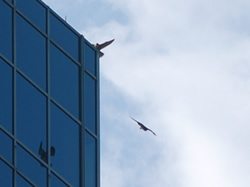
Peregrines (and other birds) can confuse a reflection for a real bird; disaster can sometimes result.
Click to enlarge
|
Some cities have begun to address these problems by changing lighting systems: Toronto (www.toronto.ca/lightsout/) and Chicago (www.lightsout.audubon.org/) have lessened these threats and reduced mortality of migrating birds. The U.S. Fish and Wildlife Service in NJ is working with casino-hotel managers to make similar improvements in Atlantic City, important because of its location in a migratory pathway along the coast.
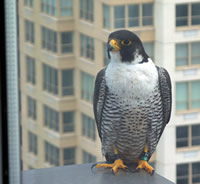
Click to enlarge |
Of course, windows can also provide us with startling and wonderful views of wildlife, including peregrines. This photo was taken about 3 blocks north of 101 Hudson St., at Plaza 5, 31st floor ledge, right after noon on July 8 by Tom K.
Now that the young peregrines have fledged they are rarely on camera - in fact, we will be shutting down the camera for the season soon. For those interested in reliving part of the season, and seeing a "timeline" of growth, visit the new As Peregrine Chicks Grow page.
|
July 13, 2009
Peregrine watchers Bonnie T. and Mike G. were out Friday through Sunday, and saw lots of flying by the whole family! The two fledglings are indeed honing their flight skills, while still calling Hudson Street ďhome base.Ē This should continue for a few more weeks before they start ranging further, because they still have a lot to learn. They need to figure out how to find and capture prey, and so far itís been easier to beg from their parents. Their parents know the fledglings have to get hungry enough to try some new moves.
Friday, July 10, from Mike:
"From 11:20 to 11:48 AM adult male was perched on a pipe 1 floor below where the box is. He flew off heading west. At 11:52 what appeared to be adult female appeared off the NE corner of 101 Hudson. She turned around to head west as well. I didn't see when or where she may have returned to.
"At 12:30 PM adult male came back in from the west, and the female fledgling took off to meet him (hadn't seen the fledglings before this time). She followed him back to the top of 101 Hudson. At that moment the male fledgling appeared, and both fledglings were above 101 Hudson for a moment. The female disappeared over a ledge 1 floor above the box, the male landed on the ledge next to the box. Adult male circled back to the west before curving back to land on a ledge 1 floor below the box.
"At 12:33 the male fledgling took off to the north, then circled back to 101 Hudson, landing on a center column near the box and giving a food-begging vocalization.
"At 12:38 adult male took off heading in a NW direction. The male fledgling briefly chased him, then turned back to 101 Hudson and landed on a NE corner ledge a few floors below the floor the box is on.
"At 12:41 the female fledgling re-appeared, briefly perching near the nestbox. She took off, circled over the western side of 101 Hudson, then northward over Columbus, then back to a center column near the box. By this time the male was no longer on the NE ledge.
"At 12:44 the female fledgling took off again, landed on the west side of 101 Hudson, flew back to the ledge near the box, then appeared to hop down to the roof.
"At 12:55 a fledgling (not sure which one) took off, made 2 circles over Montgomery, then appeared to land on the floor above the box.
"At 12:58, a fledgling (again, not certain which one, but this one seemed larger than the one that flew
at 12:55, so possibly the female) flew out, circled several times in-between Montgomery and Columbus, then went to land on the floor above the box.
"At 1:05 a fledgling (might've been the male), flew around the west side of 101 Hudson, then landed on a center column near the box. Same bird took off again at 1:15, and landed out of view on west side of 101 Hudson.
"From 1:22-1:25 female falcon (couldn't make out any markings to see if it was fledgling or adult) flew around the upper eastern side of 101 Hudson, and appeared to make a few dives/swoops in th"At area as well as along the roof & ledge of the level the box is on. She landed on the ledge near the box, then flew up to a column on the floor above.
"It was a little difficult for me to gauge the size of the fledglings towards the end of the visit today. So I'm not really sure if it was just 1 fledgling I was seeing over and over again, or both of them just taking turns flying. But th"At bit of frustration pales in comparison to the joy at seeing the fledglings continuing to hone their flying skills! They looked as good as they did on Tuesday."
Sunday, July 12, from Mike:
"At 10:55 AM Dad appeared on west pipe, with some blood from prey item visible on chest.
"At 10:58 AM male fledgling briefly appeared on ledge near pipe giving food begging vocaliz"Ation, hopped down to roof shortly afterward.
"At 11:05 AM Mom appeared on ledge near Dad.
"At 11:07 AM female fledgling was seen hanging out on western side of PATH building (she had a pigeon the parents brought in earlier, and had been feeding with male fledgling around 9:35 AM as per Bonnie T.).
"At 11:23 AM female fledgling briefly flew around west side of P"AtH building, then returned to perch on SW corner.
From 11:27 - 11:29 AM: female fledgling flew around north of PATH building, then began circling back towards 101 Hudson. Dad took off and both fledglings began chasing him around over Montgomery and 101 Hudson. All 3 gradually moved towards the east to P"AtH building. Fledglings continued chasing each other and disappeared over PATH building, while Dad gradually slipped below them and landed on SW corner of P"AtH. Mom remained perched on ledge, w"Atching.
"At 11:33 AM Dad flew N over Hudson (passing almost directly overhead). Male fledgling followed him shortly afterward, circled a few times over Hudson (nearly directly overhead), then appeared to land on top of parking garage at Pearl & Hudson.
"At 11:37 AM Mom took off from ledge and flew NW.
"11:55-11:57 AM male fledgling seen chasing Dad back from the north, both flew over and around east side of 101 Hudson.
From 12:04-12:06 PM adult falcon, likely Dad, seen leisurely gliding around east side of 101 Hudson, east to over PATH building, then turned west and was lost in glare of sun. Flying quite high."
July 9, 2009
Peregrine watchers Mike G. and Bonnie T. both did some street-side observations on Tuesday (July 7), hoping to confirm that the two fledglings were present and accounted for. The news is even better. Their reports follow.
From Mike:
"Arrived at 11 a.m. at the corner of Columbus and Hudson to see a fledgling perched on a ledge on the NE corner of 101 Hudson, and it stayed on the ledge for about an hour. Between 11 and 12, I also saw what was likely the 2nd fledgling near the nestbox hopping from the roof to the ledge and back to the roof a few times.
"Around 11:30 an adult landed on a ledge about 1 floor below where the nestbox is. A little after 12:00, the 2nd fledgling chased the other adult from the nestbox-level roof down onto a NE corner parapet while giving its food-begging vocalization. Then the fledgling flew off to the PATH building carrying the prey item (a few minutes later I was able to see it plucking the prey on the SW corner of that building).
"From 12-12:30 p.m., I watched from Columbus (in-between Hudson and Greene) as both fledglings took to the sky, flying around 101 Hudson and the adjacent areas (sometimes going over and around the PATH building and over Columbus where I was standing). They chased each other and chased a parent that might've had prey (a fledgling was seen eating a pigeon on a ledge on the NW side of 101 Hudson around 12:40 with its sibling patiently waiting nearby). When I was leaving around 1:40, I saw both fledglings flying once again around 101 Hudson."
From Bonnie: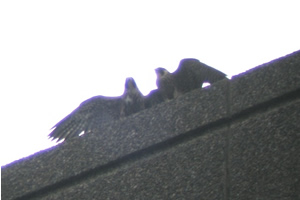
The juveniles flew very strongly around the top of 101 Hudson. We watched the very big girl (A/11) devour an equally huge pigeon. She still has a lot of white down on her chest and legs, but she can fly quite well. The little male (72/W) is agile and stealthy. We lost sight of him when he went to the south around the building. Then all of a sudden he was on the ledge just below the scrape (nest box) just taking in the scenery. The adults were positioned above and below the fledglings.
We thank Bonnie and Mike for making these very important observations and for sharing them with us. Bonnie took a couple of photos to give us an impression of those successful fledglings: nice, particularly since we will no longer find them on camera. Theyíve gained their wings, and will soon own the skies.
July 6, 2009
We have some good news to report. Local nest watcher Bonnie T. was out on Saturday, July 4, and recorded her observations:
"I was so glad to see the third fledgling get a food drop by both adults just over the scrape this morning around 10 AM. I was about to give up on seeing anything when I heard the kakking of a young one who wanted brunch. He was flying very well between the terraces on top of the building. And I do believe he was perched on the NE top pillar just prior to the food drop."
These observations indicate this young peregrine, the male of the brood, has indeed fledged successfully. One of the females (A/12) died after fledging last week, and the other female (A/11) ended up on the street. She was treated at The Raptor Trust and will be released back on the roof this afternoon. We are certainly hoping the remaining two will take their time before trying to fly in the canyons between the buildings!
July 2, 2009
We apologize for the recent video outage. After checking all the controls on our end and finding nothing wrong, we determined it was on Verizon's end, and -finally- it was restored. In the down time, we lost some good viewing opportunities of the young on the roof.
We have this news from nest watcher Bonnie T.:
"I went down on Sat. and Sun, June 27 and 28, and was treated to eyases bouncing and sleeping on the ledge. Both parents are keeping a close eye on the young. They position themselves east and west or in the middle depending on where the eyases are."
We have other observations from Michael G. from Sunday, June 28, street-side at Hudson and Columbus Avenue:
- Around 9:58-10:10 AM, observed both adults soaring over 101 Hudson & adjacent buildings. They made several fly-overs of 3 eyases on rooftop (whose begging cries were clearly heard).
- 10:02 AM, saw a possible aerial prey transfer between adults. Both birds were flying towards each other (1 from PATH building, 1 from 101 Hudson and vocalizing). They appeared to make brief contact, then separated. 1 adult flew back to 101 Hudson and appeared to land near nestbox. The other adult circled near 101 Hudson before making its way back towards the PATH building.
- 10:13-10:25 AM, saw 2 eyases sitting on the ledge stretching their wings and flapping, with both adults perched nearby (1 on the ledge between 2 eyases, the other on the corner parapet near nestbox).
- 10:30-11:15 AM, adults made occasional circles over 101 Hudson and PATH building. At 11:20 AM an adult flew N from corner parapet near nestbox and launched attack on pigeon. Both birds disappeared over a building. Adult re-appeared a minute, flying leisurely SE over to PATH building, but did not appear to be carrying prey, so no evidence of a kill from this attack.
- 11:15-11:45 AM, observed 1 eyas perched on the ledge next to nestbox. Eyas defecated once and did some wing and tail stretching but otherwise remained in place.
These observations are evidence of the young getting very ready to fledge. Just two days later, on Tuesday, June 30, one of the young did take flight. For all the reasons that flight is precarious for young birds, and primarily inexperience, he collided with a building just a block away, and was found dead. Yesterday, July 1, a second bird took its first flight from the rooftop, faring a little better but did end up on the ground. Fortunately, the bird was picked up and one of the engineers at Mack-Cali transported it to our staff, who got it to The Raptor Trust last night. We'll provide updates when we know this bird's condition, but we do hope to get him back to his parents as soon as possible.
We suspect the remaining eyas is the female of the brood, mainly because females tend to fledge 3-7 days after males. When we can confirm who's who, we'll report it here. We certainly hope to have better reports soon.
Peregrines in urban areas do face many hazards, but they are just different hazards than those in more remote situations. One of the benefits to city living is a lack of predators on the young birds. One of the trade-offs, though, is the young birds have to learn quickly how to negotiate the man-made cliff environment. We'll keep our fingers crossed. We thank all who are watching out for these birds.
June 26, 2009
A visit to the rooftop yesterday allowed a biologist to confirm that all three chicks appear quite healthy and are moving around on the rooftop. At one point an adult landed with the remains of a catch and had the soon-to-fledge chicks chase after it, providing them with physical exercise as well as reinforcing their pursuit instinct.
Unfortunately we have a technical issue whereby both the webcam's streaming and still images are not being sent from 101 Hudson St., and we were unable to resolve them during the visit. We hope to have the camera up and running soon, but at this point in their development the young falcons are likely to be out of camera range. Still, we are hopeful to get things working and catch any activity in the nest box area of the roof.
June 22, 2009
Over the weekend the peregrine nestlings were growing in attitude as they lost down feathers to flight feathers. We saw more flapping as they begin to feel the strength of those feathers. The perch location of choice seemed to be the top of the ramp, which was claimed by one of the larger females most of the time. The male nestling wanted to be there, but for much of the time had to sit right next to his sister.
Around 7:30 this morning, one of the nestlings (we think it was a female) started walking down the ramp, hesitated, then went back to perch at the opening. Just a couple minutes later, she did walk down the ramp, flapping and getting a feel for the open air. After walking under the nest box and doing some more flapping she sat on the ramp. The two in the box were watching everything, and no doubt will be joining their sibling to begin their exploration of the roof, possibly today.
Perhaps the excitement is tiring: all three of this close-knit brood were sitting in the front of the nest box by 8:15. Donít expect them to stay there long. They are getting ready for their next learning experience. The running and flapping they will do across the roof will help make them ready for a successful first flight. The adults still have a little control: the youngsters will return to the box if thatís where the meals are delivered.
June 15, 2009
On Friday, June 12, we banded the three nestlings at 101 Hudson. Two are females and one is male. Their size difference is often evident on the camera, as the male is about 1/3 smaller than his sisters.
While there, and while the nestlings were safely inside in a covered box and resting, we moved the outside camera so that it looks directly into the nest box. As viewers will see, we changed the camera feeds so that the live, streaming view is now from the outside camera, zoomed out so that we can see when the adults are perched next to the box. The inside-box view is available, but only on the still picture page.
We also left a small ramp at the nest box, because experience has shown that as the nestlings approach 4 weeks of age, they get restless and jump out of the box; without the ramp they cannot reenter the box easily. Theyíre in no danger, though, because they could find cover under the box, but the comfort of the box seems to be an important factor.
While we donít have the close-up, streaming view of the nestlings in the box, we are seeing more of what goes on outside the box: the tiercel tends to sit above the box, and at times both adults can be seen in view, sitting nearby their young.
|
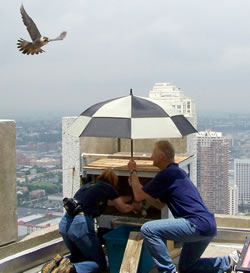 ENSP biologist Mick Valent prepares for another diving attack as Kathy Clark returns the chicks to the nestbox.
ENSP biologist Mick Valent prepares for another diving attack as Kathy Clark returns the chicks to the nestbox.
Click to enlarge
|
During banding, examination showed all three young to be very healthy. We attached the numbered federal band on their right leg, and a bicolor (black over green) band on their left leg. Their color band numbers are A/11 and A/12 for the females, and 72/W for the male. The adults remain extremely protective of their young, and we were lucky to depart unscathed and unscratched. As the nestlings approach 4-5 weeks of age no one will approach the nest area, to make sure the young birds take their time as they become ready to take their first flight.
See David Wheeler's account on the Wild New Jersey website.
June 11, 2009
Tomorrow biologists from the Endangered
and Nongame Species Program will be banding the 3-week old peregrine nestlings at 101 Hudson Street. Webcam watchers will see an empty nest box around 10:15 AM, and we will have the nestlings inside the building for about 30 minutes.
We will also use the opportunity of this visit to move the outside camera to a new position where the view will look straight into the nest box. (Other difficulties prevented us from moving this camera at the same time we installed the new nest box, pre-season.) So the outside camera, currently broadcasting the still pictures only, will be offline for the time it takes to reconfigure it.
While we're inside, the nestlings will be banded and measured, and given a general health check. We will report back on the results after Friday.
May 28, 2009
Endangered and Nongame Species Program biologists Kathy Clark and Mick Valent checked on the nestlings this morning. We took the three nestlings inside to examine them and medicate them with an antibiotic to ward off Trichomoniasis (a pigeon-borne disease that can kill young peregrines). Weíve seen Trichomoniasis often enough at Jersey City and other urban nests to know we need to act proactively. Of the three nestlings, one appeared to have mild symptoms of the disease, which the medicine should easily overcome. Otherwise, they all appeared to be doing well.
The adults were both present during our visit: the female put up a great defense, flying closely overhead. The tiercel took up his usual perch, on the parapet wall directly over the nest box, where he stood his ground. His color band reads *2/*6 [black/green], so he is the same male thatís been there since 2006. He originated from the Riverside Church (NY) in 2003, so heís six years old this year. The female wears only a silver federal band that we have not been able to read, so we donít know her origin. Both are now known for their ferocity in protecting their nest site!
We will be visiting the nest again in mid-June to band the three young. With luck they will all continue to thrive.
May 26, 2009
We were treated to an exciting Memorial Day weekend, with the hatching of all three eggs. The first two eggs hatched Friday (May 22), and the third hatched Saturday. The first feeding was observed on Friday at 12:40 PM, and we thank Jay Stahan, observer from Florida, for sending along the captured images.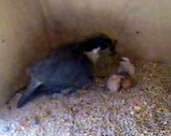
Feedings are frequent but brief, since the small hatchlings cannot eat much at a single feeding. The three are usually huddled together, which is normal behavior at that age. Fortunately, the weather has been good, and the temperatures have not been any problem for the young or the adults. The female will continue to brood them closely for the next ten days or so, and the male will continue to do much of the hunting and delivering food to the female.
We welcome the new family to 101 Hudson Street! Keep watching...they grow up fast.
May 15, 2009
Viewers have been observing the patience and diligence required to incubate eggs to hatching. It takes constant attendance by an incubating adult, keeping the eggs close to 98 degrees for 32-33 days. The female usually does most of the incubation, while the male does most of the hunting and incubates while the female takes breaks to eat and stretch. We expect hatching to occur in Jersey City around May 20-21.
| In other New Jersey peregrine nests, chicks have hatched already at some nests, beginning as early as May 2, and many nests have chicks hatching this week. ENSP staff and volunteers monitor nests to determine hatching dates and hatching success, and will keep watching to determine how many young fledge from each. We band the young peregrines when they are 3 to 4 weeks of age, just a couple weeks before they take their first flight.
All peregrine falcon nesting results are compiled and reported in our annual reports. In addition, this yearís results will be submitted to the U. S. Fish and Wildlife Service since 2009 is one of the survey years as determined by the Federal post-delisting monitoring plan.
|
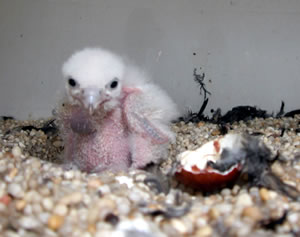 Peregrine hatching has begun in NJ, and is expected at 101 Hudson St. next week.
Peregrine hatching has begun in NJ, and is expected at 101 Hudson St. next week.
Click to enlarge
|
Peregrine falcons were taken off the Federal list of endangered species in 1999, and the U. S. Fish and Wildlife Service established a plan for monitoring populations in the 15-year post-delisting period. This is to make sure the species does not backslide after removal of Federal endangered species protections. So we will report on a sample of nests at three-year intervals that began in 2003 and end in 2015. However, we monitor the entire peregrine falcon population annually for the purposes of tracking this State-endangered species.
April 22, 2009
Happy Earth Day! Spring is in full swing, complete with seemingly endless rainy days. Those rains feed spring vegetation and overflow vernal ponds, but can be tough on birds sitting tight on their eggs, sheltering young nestlings, or trying to find food.
The Jersey City peregrines have been sitting tight on their new clutch of eggs. The second egg appeared Thursday morning, and the third egg on late Saturday afternoon. They have been sitting so tight since Saturday that we thought the clutch was complete with three eggs, but a nest watcher saw four eggs. Chances are that fourth egg was laid on Monday, April 20.
Watchers will note that the birds seem especially vigilant about incubating, which is good on these cool, rainy days. As of this season, the nest box no longer opens to the east-northeast, so the nest should be safe from the strong noríeasters weíve seen in the last few springs. The birds should be incubating constantly for the next 32 days or so, then we can look forward to some great views of hatching and chicks!
April 13, 2009
Many of us breathed a big sigh of relief today! The first egg was laid late this afternoon, after weeks of waiting and thinking, "any time now." We donít know the reason for the late start this season, but are happy that the Jersey City peregrinesí season is under way.
We can look forward to a new egg every two days or so until there is a full clutch of three or four (rarely, five). Full, close incubation begins when the clutch is complete, but the adults will brood the eggs closely when itís cool outside, and may stand near or over the eggs when itís warm out.
April 8, 2009
Spring is happening, and we are still anxiously awaiting the appearance of the first egg in the Jersey City nest. Last year, the falcons at 101 Hudson began incubation of four eggs around March 29, which means the first egg was laid around March 21. In comparison, the birds are more than two weeks behind last yearís schedule. We do not have an explanation for this shift. One possibility is that there has been a mate change in the pair. Peregrines tend to pair for life, but if one bird is injured or dies, the remaining bird will find a new mate. When that happens, the pair spends more time courting and building up their pair-bond, and nesting may be delayed.
Some peregrine pairs in the state are already incubating, but not all of them. Keep watching Ö it should happen soon in J.C.!
March 20, 2009
Unfortunately the aim of the "outside" camera generating the still image of the box has shifted. We apologize for this but are planning to relocate the camera to provide a view into the box as soon as possible.
As far as the falcons, we occasionally observe the female inside the box, but eggs have yet to be laid. That event, however, should not be far off.
March 11, 2009
Biologists returned to the roof of 101 Hudson St. yesterday to install the camera inside the new nestbox (installed last month) and reactivate the webcam. We are pleased to report that
LIVE VIDEO IS NOW STREAMING!
This is the earliest we've ever been able to activate the cameras and it will provide unprecedented images of the Jersey City falcon laying and incubating eggs inside the nestbox. While the interior of the box is only utilized occasionally at this point, this morning we did observe the female perch at the box entrance and then enter it and perform some scraping activity.
Viewers will notice the new box has been rotated to provide better protection from the elements. The outside camera will be relocated soon to provide a view directly into the box. Viewers will also notice that there are now two perches as part of the structure, one above the roof and one just outside the opening.
For now, the still image from the outside camera may provide more shots of the birds than the box camera. As egg laying and incubation approach (there is already a scrape in the gravel) there will be more activity just outside and within the box.
We encourage viewers to help support the webcam and all the work of the Endangered and Nongame Species Program through the Income Tax Check-off for Wildlife and Conserve Wildlife License Plates. We appreciate and value your support, as well as the support we've received from the Conserve Wildlife Foundation of NJ and the Mack-Cali Realty Corporation staff at 101 Hudson - without their cooperation the nestbox and webcam would not be possible.
To view the live feed or still images follow the links from the webcam homepage.
February 5, 2009
Welcome to the 2009 edition of Nestbox News!
We anticipate another exciting year observing the peregrine falcons using the nestbox atop 101 Hudson Street maintained by Endangered and Nongame Species Program. The first nestbox was installed in 2001 and has fostered the successful fledging of young every year since (see the About the Peregrine Project page for a history of the project).
This year we plan on installing a new box and changing its orientation to provide more protection from the elements. The move will require relocating the camera which should provide a better view of nesting. The webcam should be activated in early April, in time to observe incubation of eggs.
As with so many things in the state and nation at this time, funding for projects such as this is becoming harder and harder to obtain - the Peregrine Project, like other projects conducted by the ENSP, is funded entirely by grants and donations. Please help this project continue by making a direct donation to the ENSP, or by "checking-off" for wildlife on your state income tax return. By becoming a partner in the work of ENSP you can proudly feel you are doing your part in protecting our endangered and threatened species.








